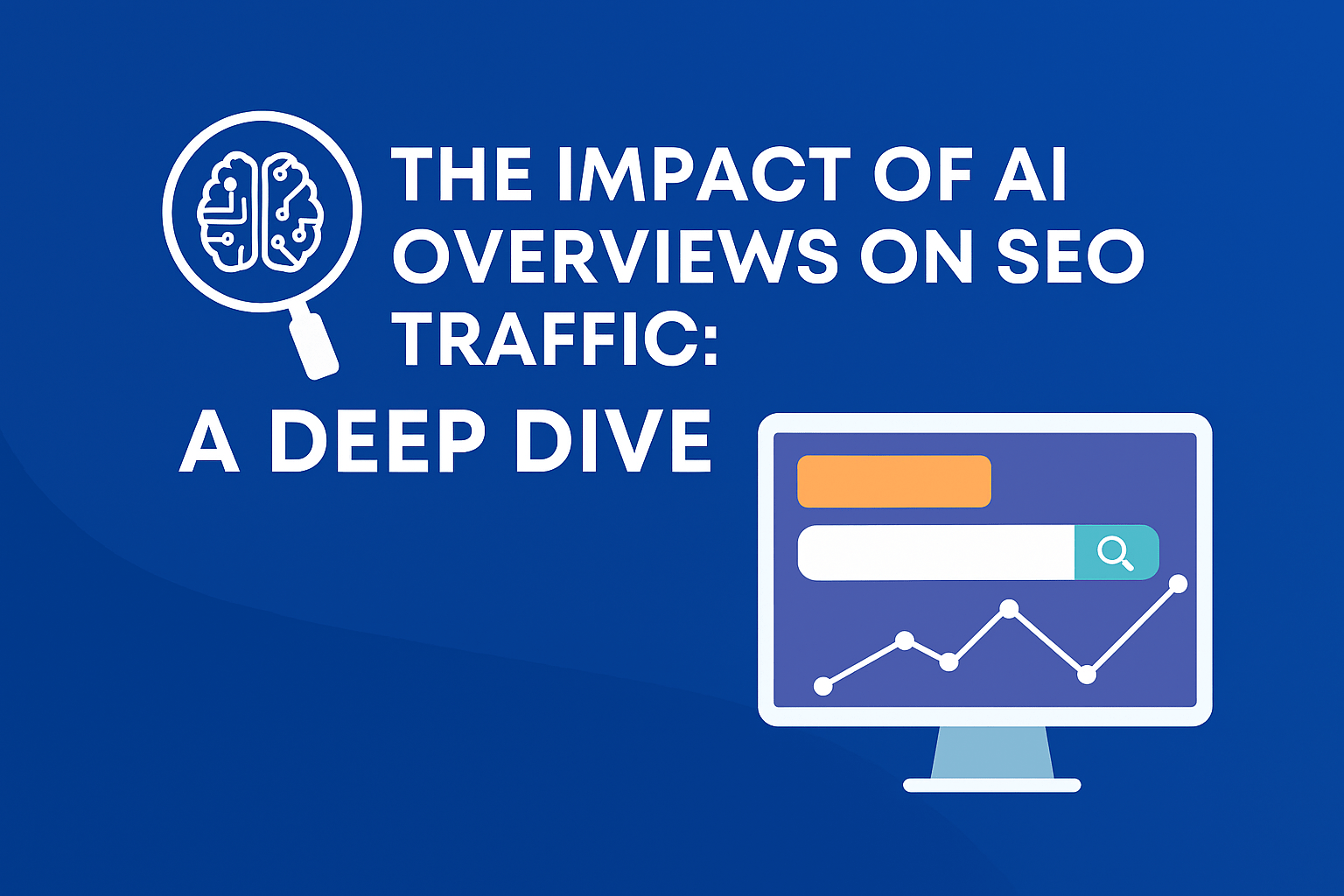The Impact of AI Overviews on SEO Traffic: A Deep Dive

In the evolving world of digital marketing and search engine optimisation (SEO), one of the most significant shifts in recent times has been the rise of AI Overviews and their effects on how users engage with search engine results pages (SERPs). In this article, we will thoroughly explore the concept of AI Overviews SEO traffic, how these AI-generated summaries are changing visibility and click-through rates, and what strategies you must adopt to stay ahead in the new search-landscape.
What are AI Overviews and why they matter
When discussing AI Overviews SEO traffic, we first must understand what AI Overviews are. Simply put, an AI Overview is a snippet or summary powered by generative AI that appears at the top of a search result—above traditional organic listings.
These summaries draw information from multiple web sources, create a condensed answer for users, and often provide links for “learn more” — thus forming a new kind of SERP feature.
They matter because they shift user behaviour: many users may find their answer in the box and not click further, or click more selectively. This alters how traffic flows and how visibility should be measured.
The state of AI Overviews in search
To evaluate the impact on SEO traffic, let’s look at current data around how frequent AI Overviews are and what types of queries trigger them.
Increasing prevalence
According to a study by SEMrush analysing over 10 million keywords, AI Overviews appeared in 13.14% of all U.S. desktop queries in March 2025, up from 6.49% in January 2025.
That shows a rapid increase in deployment of these features.
Intent and query type
The same SEMrush report found that about 88.1% of queries that trigger AI Overviews are informational in nature (vs. transactional or navigational).
Thus, a major share of the AI-Overview landscape involves “what is X”, “how to do Y”, or “why does Z happen” types of queries—especially high-trust topics like science, health, law, society.
Click-through and traffic impact
Several sources point to real impacts on click-through rates (CTR) when AI Overviews are present. For example:
-
According to Ahrefs data, pages in position 1 saw a 34.5% drop in CTR when AI Overviews appeared.
-
Another study found an average CTR decline of ~15.5% for non-branded keywords when an AI Overview showed up.
However, not all data show an automatic decline in clicks. SEMrush found that for keywords that newly triggered AI Overviews between January and March 2025, the zero-click rate actually slightly decreased (from 38.1% to 36.2%) for those queries.
Key take-aways
-
AI Overviews are no longer fringe; they’re becoming a meaningful part of SERPs.
-
The biggest impact is on informational/ top-of-funnel content.
-
Organic ranking alone may not guarantee traffic as it once did, because the summary may satisfy the user without click.
-
Traffic declines are documented — but the picture is nuanced: for some queries traffic quality may improve even as volume drops.
How AI Overviews affect SEO traffic
Understanding the mechanisms behind impact helps marketers and website owners adapt. Here are the major ways AI Overviews are reshaping the landscape.
1. Visibility shift in SERPs
With an AI-generated summary occupying prime real estate above the fold, traditional organic links may get pushed further down. This means being ranked #1 may not yield the same visibility or click volume as previously.
2. Zero-click and reduced click-through
Because the answer is provided directly in the search interface, users may not click through. This “zero-click” dynamic reduces the opportunity for websites to capture traffic from certain queries.
For example, one report noted that a site previously ranking first could lose up to about 79% of traffic for that query when an AI Overview was present.
3. Traffic quality changes
While volume may drop, the users who do click may be more qualified—i.e., they clicked because they wanted to dive deeper than just the summary.
This means metrics like dwell time, conversion rate, engagement may matter more than sheer impressions or clicks.
4. Authority, expertise and trust become more important
Since AI Overviews draw from multiple sources and emphasise credible information, signals such as author expertise, site authority, structured data/schema, updated content, and citations matter more than ever.
Basically, the “helpful content” standard is heightened.
5. Keyword / content strategy needs rework
Because AI Overviews are more likely to trigger on general informational queries, competition is increasing. Standard broad queries may get summarised and traffic diverted, so focusing on more niche, in-depth, unique angles becomes crucial.
Strategies to optimise for AI Overviews SEO traffic
With the landscape changed, here are actionable strategies to adapt with your AI Overviews SEO traffic focus.
A. Prioritise “AI-resistant” content
-
Target long-tail, highly-specific queries where AI summarisation may not suffice, e.g., detailed tutorials, case-studies, localised content.
-
Provide in-depth analysis, unique data or insights, expert commentary that go beyond the basic answer.
-
Incorporate multimedia (images, videos) and structured data/schema markup to enrich content. Visual and video content are gaining ground.
B. Improve authority, E-E-A-T and documentation
-
Emphasise author credentials, cite reputable sources, keep content fresh and updated.
-
Use schema markup (FAQ, how-to, article) to help Google understand and trust your content.
-
Build link authority and brand trust: sites with strong backlink profiles are more likely to feed into AI summaries.
C. Optimise for SERP features including AI Overviews
-
Format content to be easily extractable: clear headings, bullet points, step-by-step answers. AI summaries often pull from structured, well-formatted content.
-
Monitor which queries your site is ranking for and whether AI summaries show. Use tools to track SERP features beyond rank alone.
-
Consider diversifying traffic sources: less reliance purely on traditional organic clicks, more on brand, direct, email, social.
D. Focus on conversion and downstream metrics
-
With potential traffic volume declines, emphasise conversion rate optimisation (CRO), engagement, retention.
-
Use analytics to segment traffic from queries that likely trigger AI Overviews and track behaviour differences (bounce, time on page, goals achieved).
-
Align content with business objectives beyond pure traffic.
E. Keep monitoring and iterating
-
The AI-Overview landscape is evolving rapidly. What was informational yesterday may shift to transactional tomorrow.
-
Track how often AI Overviews show for your target keywords, how your click-through and position change.
-
Adapt content to respond quickly to ranking feature changes.
Potential challenges & risks
While the opportunities are real, there are challenges when focusing on AI Overviews SEO traffic.
-
Traffic volume reduction risk: As noted, pages ranked highly may see lower clicks when an AI summary appears.
-
Data transparency issues: Google doesn’t provide a filter in Search Console for “traffic lost to AI Overviews”. So tracking impact is more complex.
-
Content duplication & summarization risk: If your content is partly used as a source for the AI summary, you may receive little click-through. Also risk of being misrepresented or summarised inaccurately.
-
Rapid algorithm & feature changes: AI features in search are still evolving—features shifting means strategies need agility.
Future outlook: what’s next for AI Overviews and SEO traffic
Looking ahead, what will the role of AI Overviews SEO traffic be in the coming years?
-
The percentage of queries triggering AI Overviews is set to increase. SEMrush’s data already shows a big jump within months.
-
The feature may expand into more commercial and transactional queries (not just purely informational). This will further change click behaviour.
-
Search engines may integrate more conversational AI-modes where users ask follow-up questions, making the summary-first model stronger.
-
The role of websites may shift: instead of being first click destination, they may become sources cited by AI summaries, or deeper exploration portals.
-
Brands and publishers will increasingly need to think about being included in AI summaries (i.e., becoming the source) rather than just high-ranked result link.
Key take-away
-
AI Overviews are changing the rules of SEO traffic. Traditional metrics and strategies need updating.
-
Being visible isn’t just about ranking #1 anymore—it’s about being part of the answer.
-
Traffic volume may decline for some queries, but engagement quality becomes more important.
-
Adopting “AI-resistant” content, reinforcing authority/E-E-A-T, and diversifying traffic sources are critical.
-
The sooner you adapt your “AI Overviews SEO traffic” strategy, the better positioned you’ll be for the future of search.
